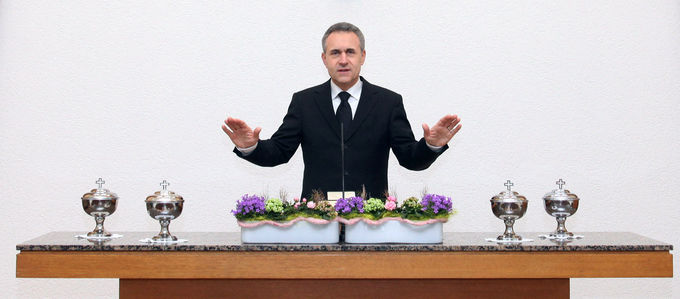Liturgy: ritual, ceremony, and much more
What is the actual sequence of a New Apostolic divine service anyway? This question comes up often, especially when guests are present in a divine service for a baptism or confirmation, for example. The liturgical order of the divine services is the same for all divine services, and applies all around the world.

Liturgy can be compared to the walls in a house or the spine in the body: constantly repeated, firmly established formulas create security and order in the divine service event. The individual elements of the divine service—for example, the preaching of the word, the dispensation of the sacraments, the benediction—have not just been placed somewhere arbitrarily, but are interrelated, and follow a clear sequence. And this firmly prescribed liturgical order is intended to make it clear to human beings that God is constantly inclined to them. All those who attend the divine service can thereby recognize the dependability of God and feel secure in His unchangeable faithfulness. Always the same, like a repeating canon, the individual liturgical elements accompany the believers through their life of faith.
The divine service is Trinitarian right from the start
After the congregation sings the opening hymn, the Trinitarian opening formula resounds: "In the name of God, the Father, the Son, and the Holy Spirit." These words are not coincidental. Rather, this invocation and worship of the triune God is the ticket to a worthy divine service: God is now present! He watches over His people. He watches over His word.
After the opening prayer and reading of the Bible text follows the sermon. In New Apostolic divine services the main portion of the sermon involves speaking the word of God in free discourse for about 20 to 25 minutes, which is followed by supplementary contributions. This is a very demanding task, both for the minister preaching as well as for the listeners. The Catechism states the following concerning this: "The interpretation of the Bible text in free discourse constitutes the core of the sermon, which is inspired by the Holy Spirit. The congregation experiences this through the words of the minister conducting the service and through supplementary contributions by assisting ministers ("serving along"). The proclamation of God's word by a number of ministers, each with a different personality and corresponding gifts, aids in illuminating several aspects of the sermon from various perspectives, and serves to deepen understanding for God's will" (CNAC 12.1.6.3).
The high point is Holy Communion
This is followed by a liturgical element of repentance. Here the congregation, each and every individual believer, bows down before the Lord in search of peace and forgiveness. They are mindful of Jesus' washing of the feet, as well as their own sinfulness. The hymn of repentance, the collective prayer of the Lord's Prayer, the absolution—a pronouncement of forgiveness from all sin and guilt—as well as the consecration of bread and wine such that the body and blood of Christ may be joined to it, lead the way to the celebration of Holy Communion. Now follows the high point of the divine service. Christ Himself steps into the congregation. "The content and significance of Holy Communion cannot be fully grasped in rational or doctrinal terms. It is closely associated with the mystery of the person of Jesus Christ. In Holy Communion, the reality of God and His devotion to mankind can be directly experienced. Holy Communion is the central event of the divine service. It also takes on a significant position in the consciousness and life of the faithful," states the Catechism (CNAC 8.2).
Last of all follows the closing prayer, along with the closing benediction and the closing hymn. The Trinitarian closing benediction discharges the congregation in the certainty that everything revolves around the triune God. His grace, love, and communion will accompany them.
All hymns, all prayers, all acts, all elements of preaching, all blessings, and all sacraments in the divine service are subject to the liturgical order of the New Apostolic Church. All ministers of the Church must adhere to this.
In a brief series, nac.today will shed some further light on the individual liturgical elements.
Photo: Frank Schuldt




